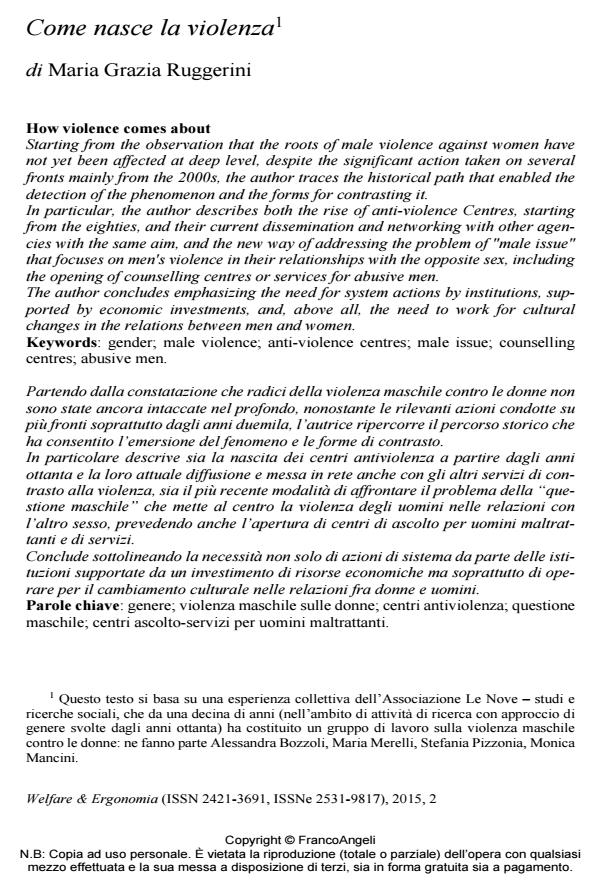How violence comes about
Journal title WELFARE E ERGONOMIA
Author/s Maria Grazia Ruggerini
Publishing Year 2017 Issue 2015/2 Language Italian
Pages 9 P. 242-250 File size 168 KB
DOI 10.3280/WE2015-002020
DOI is like a bar code for intellectual property: to have more infomation
click here
Below, you can see the article first page
If you want to buy this article in PDF format, you can do it, following the instructions to buy download credits

FrancoAngeli is member of Publishers International Linking Association, Inc (PILA), a not-for-profit association which run the CrossRef service enabling links to and from online scholarly content.
Starting from the observation that the roots of male violence against women have not yet been affected at deep level, despite the significant action taken on several fronts mainly from the 2000s, the author traces the historical path that enabled the detection of the phenomenon and the forms for contrasting it. In particular, the author describes both the rise of anti-violence Centres, starting from the eighties, and their current dissemination and networking with other agencies with the same aim, and the new way of addressing the problem of "male issue" that focuses on men's violence in their relationships with the opposite sex, including the opening of counselling centres or services for abusive men. The author concludes emphasizing the need for system actions by institutions, supported by economic investments, and, above all, the need to work for cultural changes in the relations between men and women.
Keywords: Gender; male violence; anti-violence centres; male issue; counselling centres; abusive men.
- Basaglia A., Lotti M. R., Misiti M. e Tola V. (2006). Il silenzio e le parole. ii Rapporto nazionale Rete antiviolenza tra le città Urban-Italia. Milano: FrancoAngeli.
- Bimbi F., Schenkel F. (2000). Cittadinanza delle donne nel contesto delle politiche europee contro l’esclusione sociale. In: Aa.Vv., Libertà femminile e violenza sulle donne: strumenti di lavoro per interventi con orientamenti di genere. Milano: FrancoAngeli.
- Bourdieu P. (1998). Il dominio maschile. Milano: Feltrinelli.
- Bozzoli A., Merelli M. e Ruggerini M. G. (2013). Il lato oscuro degli uomini. La violenza maschile contro le donne: modelli culturali di intervento. Roma: Ediesse (ii ed. 2014).
- De Beauvoir S. (1949). Le Deuxième Sexe. Paris: Gallimard (trad. it.: Il secondo sesso. Milano: Il Saggiatore, 1961).
- Leccardi C. (2014). Nuove soggettività femminili e crisi del futuro. In: Mori M. T., Pescarolo A., Scattigno A. e Soldani S., a cura di, Di generazione in generazione. Le italiane dall’Unità a oggi. Roma: Viella, pp. 375-88.
- Melandri L. (2011). Amore e violenza. Torino: Bollati Boringhieri.
- Merelli M. (2015). Le radici culturali dei Centri antiviolenza. L’equilibrio costante tra politica e servizio. Seminario promosso dalla Cooperativa E.V.A. 1 (Napoli, 30 marzo). --Testo disponibile al sito: http://www.edvitaly-project.unimib.it/wp-content/uploads/2015/10/Merelli-Politicita-CAV.pdf.
- Merelli M., Ruggerini M. G. (2014). La sicurezza nelle normative regionali di contrasto e prevenzione della violenza di genere contro le donne. Intervento al Convegno Internazionale “Quali politiche per la sicurezza?” (Perugia, novembre).
- Palladino R. (2015). Lavoro sociale e sguardo di genere. In: Morniroli A., a cura di, Equilibristi. Lavorare nel sociale, oggi. Torino: Ed. Gruppo Abele.
- Romito P. (2005). Un silenzio assordante. La violenza occultata su donne e minori. Milano: FrancoAngeli.
- Rubin G. (1975). The Traffic in Women: Notes on the “Political Economy” of Sex. In: Reiter Rayna R., ed., Toward an Anthropology of Women. New York: Monthly Review Press.
- The Boston Women’s Health Book Collective (1971). Our Bodies, Ourselves (trad. it.: Noi e il nostro corpo. Scritto dalle donne per le donne. Milano: Feltrinelli, 1974).
Maria Grazia Ruggerini, Come nasce la violenza in "WELFARE E ERGONOMIA" 2/2015, pp 242-250, DOI: 10.3280/WE2015-002020